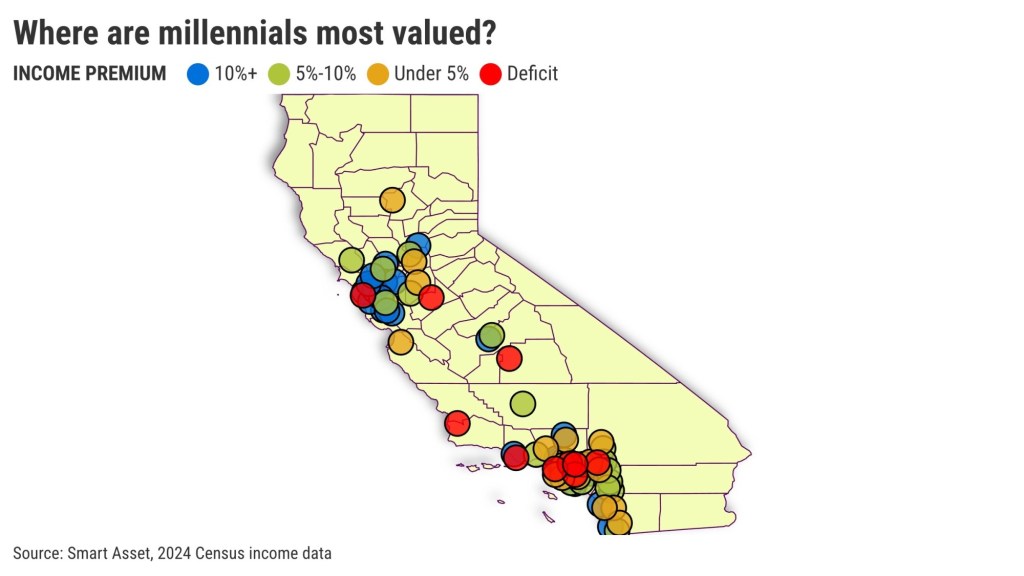
California’s young adults earn significantly more than their peers nationwide – but those millennial incomes are not substantially above the Golden State’s norms.
My trusty spreadsheet reviewed SmartAsset’s scorecard of 2024 incomes for households headed by millennials in 357 large U.S. cities – including 77 in California. The earnings of this age 25-to-44 cohort were compared with overall incomes for each city to calculate the premium pay of millennials – or, in rare cases, a problematic earnings deficit.
Start with the median household income for California’s city-dwelling millennials at $109,600. That’s 33% above the $82,600 median in the cities outside of California.
Next, consider the overall median income of $101,200 in California compared with $76,100 elsewhere – also a 33% gap.
While California millennials are clearly well-compensated compared with their national peers, consider the modest premium they earn in-state.
The median income for Golden State millennials is above what all California city households earn. That’s the same percentage-point bump found in cities elsewhere in the U.S.
Keep in mind that income levels drive demand for goods and services. The size of paychecks is a key variable in the local cost of living.
This modest millennial pay premium across California can be a source of financial stress for a youthful group facing, among other challenges, the task of raising children or the high cost of buying a home in the Golden State.
Low points
In 10 of these 77 California cities, millennial earnings trail overall incomes – that’s 13% of the state, indicating a high potential for financial stress.
Outside the Golden State, millennials earn less than the overall income in 26 of the 280 cities, which is just 9%.
Those 10 California cities are topped by Santa Maria, where millennial household incomes of $66,000 are 12% below $75,000 for all. That 12% deficit was the third-largest of 357 cities nationwide.
The other nine, ranked by their millennial income deficit …
West Covina: 9% deficit (No. 6 highest in U.S.) – $91,800 millennial income vs. $101,300 for all.
Daly City: 7% deficit (No. 10) – $109,600 millennial vs. $117,900 for all.
Inglewood: 5% deficit (No. 16) – $66,200 millennial vs. $69,400 for all.
Visalia: 2% deficit (No. 25) – $83,300 millennial vs. $84,800 for all.
Fontana: 1% deficit (No. 29) – $107,500 millennial vs. $108,700 for all.
Anaheim: 1% deficit (No. 32) – $100,400 millennial vs. $101,100 for all.
Oxnard: 1% deficit (No. 33) – $100,400 millennial vs. $101,200 for all.
Modesto: 1% deficit (No. 34) – $78,600 millennial vs. $79,200 for all.
El Monte: 1% deficit (No. 35) – $70,000 millennial vs. $70,500 for all.
Regionally speaking
This millennial pay premium varies widely across the state.
It’s no surprise that the best pay for millennials is in the tech-centric Bay Area, with a 21% premium across 16 cities: $132,100 for millennials vs. $108,900 for all workers.
And the Bay Area is home to the state’s largest millennial premium – Berkeley’s 42%, the second-highest in the nation: $147,000 for millennials vs. $103,700 for all.
Contrast that to Southern California’s 6% premium: $107,100 for millennials in 46 cities vs. $101,200 for all.
In the rest of California, there’s a 10% premium: $96,900 for millennials vs. $87,800 for all.
Jonathan Lansner is the business columnist for the Southern California News Group. He can be reached at jlansner@scng.com



